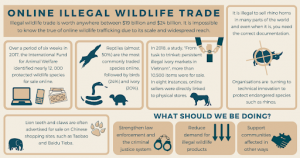This article is written by Jyotiranjan Mallick, pursuing Diploma in Cyber Law, FinTech Regulations, and Technology Contracts from LawSikho.
Table of Contents
Introduction
The term wildlife constitutes one of the most represented nomenclatures under the ambit of flora and fauna. The term was first used by the famous American zoologist William Temple Hornaday in his book “Our Vanishing WildLife (Its Extermination and Preservation)” which was published in 1913 and came into use in the early 1930s. As per Section 2(37) of the Wild Life (Protection) Act, 1972, “wildlife” includes any animal, aquatic or land vegetation that forms part of any habitat. In the context of the Indian constitution, various safeguards have been ensured for the proper preservation and upkeep of the wildlife including Article 48 A and Article 51A (g) of the Constitution says that “It shall be the duty of every citizen of India to protect and improve the natural environment including forests, lakes, rivers and wildlife, and to have compassion for living creatures”. This signifies the prominence of wildlife in the protection of the environment.
A serious threat to the protection of wildlife around the world is posed by wildlife crimes. Wildlife crime can be defined as taking, possession, trade or movement, processing, consumption of wild animals and plants or their derivatives in contravention of any international, regional, or national legislation(s). In the digital age, wildlife crime is exacerbated by the use of the internet and complex technologies to facilitate the promotion of the sale and purchase of exotic animal products that contribute to the rise of such crimes.
The use of cyber portals to facilitate such sale and purchase not only results in more wildlife cybercrime but owing to the complexities involved in ascertaining jurisdictions in internet-related crimes, it becomes highly difficult to nab the culprits. This is specifically worrying in the case of transnational cyber wildlife crimes where ascertaining jurisdiction becomes even more complex. The internet also facilitates the advertisement of such crimes while simultaneously allowing anonymity. This unregulated and anonymous nature of wildlife cybercrime, often with little to no monitoring or no enforcement action being taken against wildlife cybercriminals results in further exacerbation of the issue.
Wildlife offences at a glance
Hunting and the unlawful trading of exotic wildlife species constitute the major chunk of wildlife offences. This includes various activities such as preparation for hunting, poaching the animal, extracting the useful part of the target animal, managing the transport and selling. The list being not exhaustive, these offenders can be classified into two groups. The first is represented by the poachers and hunters who are primarily involved in the execution of a target animal and the second part is represented by the side that creates the demand, this includes the person buying such material for consumption or for trading in arbitrage.
Hunting and poaching of Rhino horns serve as a great source for meeting the demand for medicinal potions, grey parrots are captured to be made as exotic pets for the rich and criminal networks hunt and sell elephant tusks in the global market. The statistics are very grim, in the past decade more than 10,000 rhinos have been killed for their horns. Today the decimation of the population has reduced the mark to less than 28000 around the world. Similarly, the numbers show that more than 20,000 elephants have been killed for their tusks which has resulted in a massive reduction in their numbers. More elephants are killed than are born each year. This same story is also true for the African grey parrot which has been recently listed in Appendix I of CITES, resulting in the total ban of commercial activities involved with such species. These are some of the few examples of how such illegal trade is being carried out through the internet.
Jurisdictional challenges of online crime
One of the crucial aspects of prohibiting wildlife cybercrimes is the process of ascertaining jurisdiction where the wildlife cybercrime took place. The complexity associated with the digitalization of such networks makes it highly difficult to ascertain the jurisdiction. The internet, as previously discussed, facilitates activities from remote locations without the fear of being tracked using sophisticated technologies. Even in the absence of such technologies, the internet allows transnational cyber wildlife crimes wherein two different municipal jurisdictions are involved. The involvement of two or more geopolitical units such as countries makes it more complex to nab the criminal due to certain factors such as lack of mechanism/treaty to determine the place of crime, issues involving the extradition of the criminal from one state to another, the geopolitical conflict between the two nations which halts the processes of ascertaining jurisdiction.
In the case of internet-related crimes, the same involves numerous stakeholders which include the poacher, the person facilitating the advertisement on the internet, the buyer, the seller, etc. The criminal conduct may originate from any geographical location. The individuals involved may or may not be nationals of the location where the crime is committed. The species being traded may or may not be from that same jurisdiction, and may or may not be legally traded in the jurisdiction where they are offered or purchased.
These complexities create difficulty in assigning as to whom liability may attach (the seller, the purchaser, the advertiser, the shipper, an individual, a legal entity), in what form (criminal, civil, administrative) and at what amount. One of the key pointers for determining the jurisdiction of a crime is the “territorial principle” wherein the land from where the crime was executed is the place of jurisdiction.
However, as previously discussed in the case of wildlife cybercrime, even though the place of jurisdiction is the location where such an animal was hunted, it only addresses one aspect of the crime. This is because after the killing of such animals the entire process of wildlife trade is facilitated through the internet which constitutes a separate offence. This offence becomes difficult to investigate due to the complexities associated with ascertaining the jurisdiction through the internet as has been previously elaborated.
Role of social media in facilitating wildlife cybercrime
Social media tends to be a dominant platform in holding the marketplace for the sale and purchase of exotic wildlife products. Although the percentage of social media is less in comparison to the traditional use of online forums and the dark web. However, the growing percentage of its mainstream use is a worrying factor for many. In a 2014 report of International Fund for Animal Welfare(IFAW) report Wanted – Dead or Alive, social media platforms and forums in China were reported to be responsible for more than half the trade as compared to online marketplaces, reflecting a broad change in the online shopping habits of Chinese consumers.
The popularity of social media platforms was also highlighted in the news when in 2016, Wildlife Justice Commission investigation in Vietnam nabbed an international racket of wildlife traders who used Facebook and WeChat as a part of their operations to sell illegal wildlife products worth US $49.1 million. To curb such practices, platforms like Instagram have come forward and pledged to restrict such activities. Instagram announced that any user searching for posts featuring wildlife will be greeted with a message that the company does not support animal abuse or such activities are prohibited on their platform.
Way forward to curb wildlife cyber crimes
The world’s largest conservation forum, CITES, shared measures to tackle wildlife cybercrime through the adoption of Decision 17.92 on Combating Wildlife Cybercrime at the CITES Conference of the Parties (CoP) 17 in 2016. The agreement formulates an effective step to manage legislation, frame policies at the domestic level and establish safeguards both in offline and online mode to ensure curb on such crimes. IFAW, on the other hand, has constantly established its foothold by collaborating with online tech companies to tackle the same. This is done by encouraging them to adopt policies prohibiting the trade of protected species and assisting with the implementation of those policies.
Apart from the example of Instagram, a number of leading tech giants have come forward in this regard. In 2016, seven companies – namely eBay, Etsy, Gumtree, Microsoft, Pinterest, Tencent and Yahoo! – united to adopt a new policy framework that helps in the early detection of such wildlife marketplaces and in certain cases, prohibit access to the same by reporting the concern to the domestic authority.
Similarly in 2018, marking an unprecedented coalition to fight such crimes, a total of 21 technology, e-commerce and social media companies including Google, eBay, Etsy, Facebook, Instagram, Microsoft, Tencent, Baidu and Alibaba implemented automation that would prohibit such market place in the very first place. eBay was one of the first online technology companies to introduce a policy protecting elephants by banning the ivory trade on its site in 2009. This was done in collaboration with IFAW, WWF and TRAFFIC to launch the first-ever Global Coalition to End Wildlife Trafficking Online, with the aim of collectively reducing wildlife trafficking across platforms by 80% in 2020.
Under such initiatives, thousands of marketplaces have been removed resulting in a rapid decrease of such marketplaces. However, even after managing such platforms, there still remain numerous challenges for such tech companies. One of the prominent challenges is optimizing the existing capacity to frame such algorithms that can detect such marketplaces, with the evolution of the technology such cybercriminals have equipped themselves with necessary encryption that evades the examination of such activities. Challenge also remains to effectively analyze and manage thousands of such websites that facilitate the sale of such wildlife species.
Conclusion
Considering the seriousness of these issues, there should be proper coordination among online technology companies, enforcers, policymakers, academics and NGOs to create a counter-strategy to tackle wildlife cybercrime. On a domestic level, national governments, specifically of the nations with rich fauna and high density of wildlife cybercrime, must ensure sufficient capacity is met in terms of technology and human resources to tackle such crimes. Similarly, a great deal of improvement can be made by creating awareness among people to comply with the laws around protected species.
Students of Lawsikho courses regularly produce writing assignments and work on practical exercises as a part of their coursework and develop themselves in real-life practical skills.
LawSikho has created a telegram group for exchanging legal knowledge, referrals, and various opportunities. You can click on this link and join:













